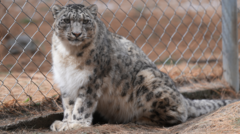With approximately 6,327 river dolphins in Indian rivers, including the endangered Gangetic species, conservation efforts are underway but the challenges remain daunting, from habitat disturbances to poaching.**
River Dolphins in India: Struggling for Survival Amidst Threats**

River Dolphins in India: Struggling for Survival Amidst Threats**
A recent survey reveals that India's Gangetic dolphins, the national aquatic animal, are facing significant challenges to their survival.**
**India's rivers are home to 6,000 dolphins - but they are in trouble**
India's illustrious Ganges River, revered for its spiritual significance, is also a sanctuary for thousands of dolphins, but their survival hangs by a thread. Unlike their oceanic counterparts, these river dolphins do not engage in graceful leaps above the water or swim gracefully. Instead, they exhibit unique behaviors: swimming sideways, preferring to stay submerged for long periods, and possessing long, slim snouts while being nearly blind.
Known as Gangetic dolphins, these creatures form a vital part of India's biodiversity, primarily inhabiting the Ganges-Brahmaputra river system in northern India. A comprehensive new survey has revealed that approximately 6,327 river dolphins reside in India, predominantly 6,324 of which are Gangetic, with a mere three belonging to the Indus dolphin species, largely found in Pakistan.
Listed as "endangered" by the International Union for Conservation of Nature (IUCN), the survival of both species is increasingly jeopardized. Conducted by researchers from the Wildlife Institute of India, this survey encompassed 58 rivers across ten states from 2021 to 2023, providing crucial data on the current population status of these river dolphins.
The fascinating evolution of river dolphins adds layers to their plight. Considered “living fossils,” these dolphins diverged from their marine ancestors millions of years ago. Historical flooding allowed them to venture inland, ultimately leading to adaptations for life in the murky waters of rivers, where they developed traits distinct from their oceanic relatives.
The recent survey is pivotal for understanding river dolphin population dynamics. Since 1980, more than 500 dolphins have perished, many as collateral damage from fishing activities or intentional killings. Conservationist Ravindra Kumar Sinha points out that public knowledge of river dolphins was scant until the early 2000s. The Gangetic dolphin was pronounced India's national aquatic animal in 2009, spurring conservation efforts, including a 2020 action plan and the establishment of dedicated research centers in 2024.
Nonetheless, the road ahead is fraught with challenges. Dolphins are frequently hunted for their flesh and blubber, fodder for the fishing industry. Collisions with boats and fishing nets exacerbate their decline. Nachiket Kelkar of the Wildlife Conservation Trust observes that many fishermen are reluctant to report accidental dolphin deaths out of fear of legal repercussions, leading to underreporting of fatalities.
In recent years, river cruise tourism has surged, further encroaching on dolphins' habitats. Experts, including Sinha, warn that the increasing presence of cruise vessels jeopardizes the delicate species by introducing disturbances and noise that the sensitive dolphins cannot endure.
Their specialized dependence on echolocation—coupled with their near blindness—enables these dolphins to navigate murky waters but also heightens their vulnerability to modern perils. Slow reproductive rates compound their challenges, as females give birth only every two to three years, maturing into adulthood over six to ten years.
Despite the obstacles, Sinha remains optimistic about the Gangetic dolphins' prospects. "Government initiatives have played a significant role in preserving the dolphins. While substantial progress has been made, our efforts must continue," he emphasizes.
India's illustrious Ganges River, revered for its spiritual significance, is also a sanctuary for thousands of dolphins, but their survival hangs by a thread. Unlike their oceanic counterparts, these river dolphins do not engage in graceful leaps above the water or swim gracefully. Instead, they exhibit unique behaviors: swimming sideways, preferring to stay submerged for long periods, and possessing long, slim snouts while being nearly blind.
Known as Gangetic dolphins, these creatures form a vital part of India's biodiversity, primarily inhabiting the Ganges-Brahmaputra river system in northern India. A comprehensive new survey has revealed that approximately 6,327 river dolphins reside in India, predominantly 6,324 of which are Gangetic, with a mere three belonging to the Indus dolphin species, largely found in Pakistan.
Listed as "endangered" by the International Union for Conservation of Nature (IUCN), the survival of both species is increasingly jeopardized. Conducted by researchers from the Wildlife Institute of India, this survey encompassed 58 rivers across ten states from 2021 to 2023, providing crucial data on the current population status of these river dolphins.
The fascinating evolution of river dolphins adds layers to their plight. Considered “living fossils,” these dolphins diverged from their marine ancestors millions of years ago. Historical flooding allowed them to venture inland, ultimately leading to adaptations for life in the murky waters of rivers, where they developed traits distinct from their oceanic relatives.
The recent survey is pivotal for understanding river dolphin population dynamics. Since 1980, more than 500 dolphins have perished, many as collateral damage from fishing activities or intentional killings. Conservationist Ravindra Kumar Sinha points out that public knowledge of river dolphins was scant until the early 2000s. The Gangetic dolphin was pronounced India's national aquatic animal in 2009, spurring conservation efforts, including a 2020 action plan and the establishment of dedicated research centers in 2024.
Nonetheless, the road ahead is fraught with challenges. Dolphins are frequently hunted for their flesh and blubber, fodder for the fishing industry. Collisions with boats and fishing nets exacerbate their decline. Nachiket Kelkar of the Wildlife Conservation Trust observes that many fishermen are reluctant to report accidental dolphin deaths out of fear of legal repercussions, leading to underreporting of fatalities.
In recent years, river cruise tourism has surged, further encroaching on dolphins' habitats. Experts, including Sinha, warn that the increasing presence of cruise vessels jeopardizes the delicate species by introducing disturbances and noise that the sensitive dolphins cannot endure.
Their specialized dependence on echolocation—coupled with their near blindness—enables these dolphins to navigate murky waters but also heightens their vulnerability to modern perils. Slow reproductive rates compound their challenges, as females give birth only every two to three years, maturing into adulthood over six to ten years.
Despite the obstacles, Sinha remains optimistic about the Gangetic dolphins' prospects. "Government initiatives have played a significant role in preserving the dolphins. While substantial progress has been made, our efforts must continue," he emphasizes.






















